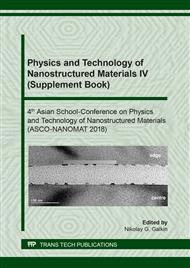p.3
p.10
p.17
p.24
p.30
p.39
p.45
p.51
p.57
An Influence of the Si(111)3-4o Vicinal Surface on the Solid Phase Epitaxy of α-FeSi2 Nanorods and their Crystal Parameters
Abstract:
The morphology and structure of iron silicide nanorods formed on Si (111) vicinal surface by the SPE method at T = 630 °C were studied. Optimal Fe coverage and Fe deposition rate for the formation of a dense array of the nanorods (54-65% of the substrate area) on Si (111) surface with 3-4o miscut angles were established. The aspect ratio of the nanorods is 1.9 – 3.3. Cross-sectional images of a high-resolution transmission electron microscopy (HRTEM) have shown that the nanorods have α-FeSi2 crystal structure. They are strained along the “a” axis and stretched along the “c” axis, which increased the unit cell volume by 10.3%. According to HRTEM image analysis, the nanorods have the following epitaxial relationships: α-FeSi2[01]//Si [10] and α-FeSi2(112)//Si (111). All the data obtained have provided, for the first time, a direct evidence of α-FeSi2 nanorods formation on Si (111) vicinal surface without noticeable penetration of Fe atoms into the Si substrate.
Info:
Periodical:
Pages:
30-35
Citation:
Online since:
June 2019
Keywords:
Price:
Сopyright:
© 2019 Trans Tech Publications Ltd. All Rights Reserved
Share:
Citation:


